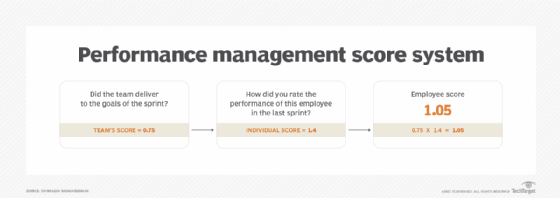
RFsole - Fotolia
Rethink IT performance management with a simplified, objective approach
Performance management can be daunting for IT organizations but it doesn't have to be. Here's how business execs can take on a more simplified, objective and effective approach.
Performance management is common across all industries, but it tends to be more challenging and complex for IT organizations. With remote workers, global operations and multiple reporting channels, it's become increasingly important for IT organizations to redefine their performance management process and create one that recognizes meritocracy, rewards high performances and provides timely corrective messages.
The primary challenge is to remove the bias, subjectivity and ambiguity from the performance management process and make it more objective -- an approach that facilitates clarity and fairness. Several organizations are moving in this direction, spurring others to follow suit and rethink their performance management processes.
Another challenge IT organizations face is to determine how to meet the dynamic needs of their business partners and internal customers. In most cases, the feedback given to IT by their customers' organizations is that IT is not delivering on the expectations of the business. As the saying goes, "use a thorn to remove one;" it's possible that the performance management system is designed to have one challenge address the other. This new approach removes the bias from the performance management process and simultaneously ensures that IT delivers according to customers' needs.
"Making the simple complicated is commonplace; making the complicated simple, awesomely simple, that's creativity" jazz composer Charles Mingus once said.
To fix the complex performance management problem, consider the following simplistic and fundamental approach that utilizes an Agile framework.
The Agile framework
In recent years, there has been a significant move toward the "Agile" way of working in IT organizations. The Agile approach promotes teamwork and delivers results in shorter sprints ranging from two to five weeks. In line with the roles defined in the Scrum Guide, all Agile teams have a product owner representing the business or the customer organization. The performance management system uses this model and adheres to the way IT organizations work rather than suggesting something tangential to how IT operates.
Simplifying the entire performance management process involves answering two questions periodically throughout the year. The first question is, "Did the team deliver to the goals of the sprint?" It is answered by the business product owner at the end of every sprint with either "yes" or "no" and applies to the whole team. "Yes" is considered "1" and "No" as "0." This first score, which is the same for everyone in the team including the manager, is then averaged at the end of the performance period.
This question is intended to lead to productive discussions between IT and its business partners. This way, the focus will shift toward meeting the goals in every sprint and will ensure IT is making realistic plans. The Agile teams will come up with the right sprint duration that works for their goals and will ultimately improve the collaboration between IT and the business. Meeting these goals in every sprint means effectively meeting the overall business needs. Therefore, it's a simple question that can provide objective performance management at the same time IT is making sure it delivers to the business needs.
The second question is "How do you rate the performance of this employee in the last sprint?" It is answered by everyone on the team and each participant provides a rating for every other team member. The responses may include: "below expectations," "met expectations" and "exceeded expectations." Asking this question can enable and enhance teamwork, which is at the core of the Agile framework.
Here is an example of this type of performance management system. In a quarter, if a team has four sprints each over a three-week duration, the rating will be done four times. If the team got three yeses and one no as responses to the first question, the score for everyone on the team for the quarter is three out of four, which is 0.75.

For a 10-member team, one team member would receive nine times four sprints, which totals to 36 responses. The average of all 36 will be taken and to compute this average, the scoring for "met expectations" will be 1, "below expectations" will be 0 and "exceeded expectations" will be 2.
For a team member who scored an average of 1.4 at the end of the quarter, the final individual score for the quarter will be 1.4 times 0.75 for the overall team's score, which is 1.05. Another team member might have earned an average of 0.8 for the second question. For this team member, the final individual score for the quarter will be 0.8 times the team's score of 0.75, which equals 0.6.
The IT organization can set baseline standards such as the below 1 score indicating "development needed" and above 1 indicating "doing good" and so on. These baselines can be different depending on the levels within the organization. For example, at the lower levels of the organization, it can be below 0.85 instead of below 1 to determine "development needed." As the levels go up, this rating system can become more severe, since the expectations are higher for employees in senior positions.
Performance reviews
Any simplistic survey tool would suffice to configure these two questions, with the survey being presented at the end of every sprint. The scores will be made transparent at the end of every sprint and the summary will be available at the end of the quarter for review and discussion.
The final annual score is then used to determine the merit increases, promotions as well as any performance improvement messages. The annual merit budget can easily be distributed based on these scores and therefore without bias. There wouldn't be any surprises since the scores have been transparent all along.
In addition, this process enables regular periodic conversations between the manager and employee with a laser focus on employee performance and development. Everyone in the organization will have a concrete understanding of the company's overall strategy and how their work is aligned with the goals of their organization.
It's hard to believe but it's true. Any organization can simplify the complex performance management process by answering the two questions periodically. By utilizing this process, companies can remove the possibility of all bias and incorporate a fully transparent system resulting in an energized, happy and motivated workforce. Even better, it enables IT to deliver to customers' needs by exercising the Agile way of working.
About the Author:
Srinivasan Radhakrishnan (Srini) is an IT professional with over 25 years of global IT and academic experience. Srini holds an M.S. in Engineering and multiple professional certifications (PgMP, PMI-ACP, PMP, CSCP, CSM, LSSYB, SAP BW, AWS-CCP and SAA). Srini worked with Intel for 16 years and is currently a faculty member with the W. P. Carey School of Business at Arizona State University. For more information please email [email protected] or visit www.sriniradhakrishnan.com.




